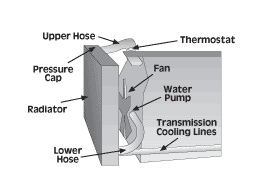| What does my heating and cooling system do?
The cooling system keeps the engine from overheating by transferring the heat produced by the internal combustion engine to the air. It also allows the engine to heat up as quickly as possible, and then keeps the engine at a constant temperature.
How does my heating and cooling system work?
The cooling system circulates a fluid through pipes and passageways in the engine. As this liquid passes through the hot engine, it absorbs heat, which cools the engine. After the liquid leaves the engine, it passes through a radiator, which transfers the heat from the fluid to the air blowing through the radiator. Key system components include anti-freeze, cooling fans and the radiator.
KEY SYSTEM COMPONENTS
Antifreeze
Antifreeze is mixed with a precise volume of water to produce a solution that lowers the freezing point of the water, reducing the likelihood that the fluid in your closed cooling system will freeze, expand and damage the engine block and other system components. Antifreeze also raises the boiling point of water under pressure, enhancing the cooling system's ability to remove and dissipate heat.
Cooling Fans
If you're stuck in traffic or driving slowly you need something to move the air around your engine over the radiator, and cooling fans do just that. Usually mounted just behind the radiator, there are two types of cooling fans, belt powered and electric powered.
Radiator
Air flows through the radiator to dissipate the heat which the coolant has absorbed from the engine.
|
Radiator Cap & Hoses
The radiator cap is designed to keep the coolant circulating under pressure, which is a crucial part of the cooling process. Hoses connect the engine and the water pump to the radiator.
Thermostat
The thermostat is responsible for allowing the engine to warm up to the proper operating temperature before allowing the cooling system to begin circulating coolant. Located between the engine and the radiator, the thermostat is a temperature-sensitive spring valve which stays closed during engine warm-up and opens when the system reaches the proper operating temperature.
|
